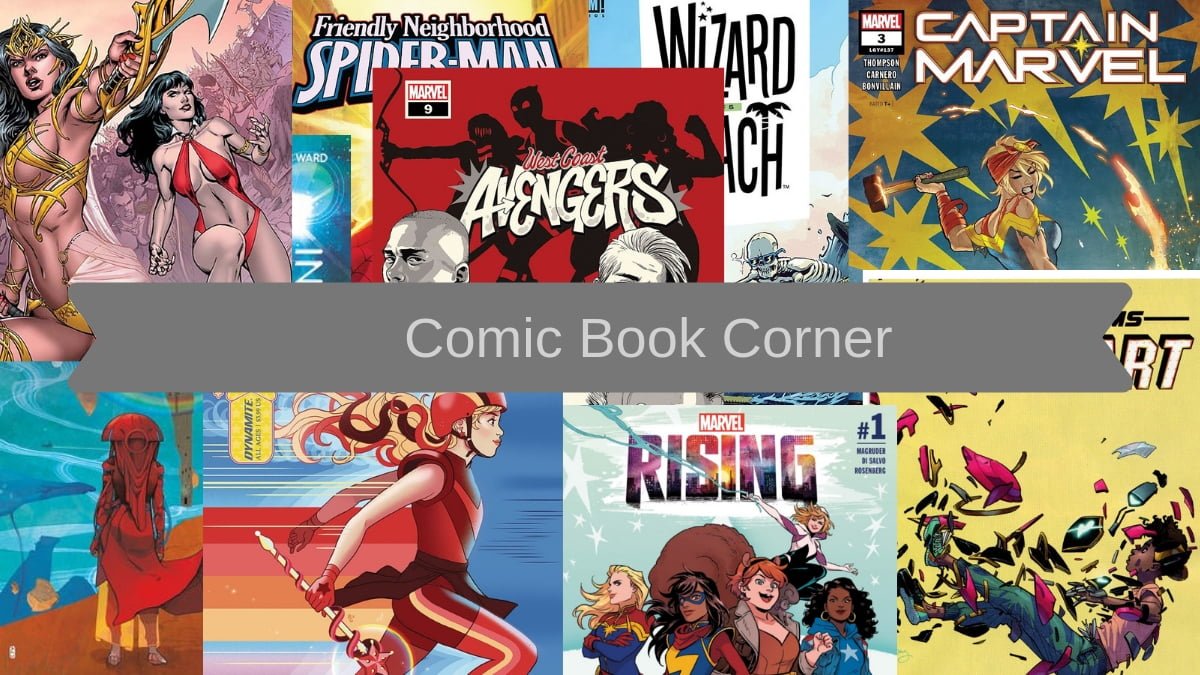
When Comic Book Corner accidentally takes a couple weeks off, you get the benefit of a rather huge catch-up post!
We’ve got all kinds of books for you to learn about today, from Captain Marvel to the wrap up of Vampirella/Dejah Thoris to first issues of Ronin Island, Invisible Kingdom, and Marvel Rising.
We liked more than we didn’t this time around, but nothing is every perfect! Keep reading to find out what we loved, what we liked, and what we wished had been done differently.
Let’s get going…
Captain Marvel Issue #3

Writer: Kelly Thompson
Artist: Carmen Carnero
Color Artist: Tamra Bonvillain
Cover Artists: Amanda Conner & Paul Mounts
Publisher: Marvel
Kay: I am deeply loving this new Captain Marvel series from Kelly Thompson. For one thing, it’s a great jumping on point for folks who have just seen the movie and don’t know where to start with comics (although Mathias wrote a comprehensive guide to collecting her books, and I touched on what books I think are the most essential to understanding her).
So in our last issue, we saw that Carol was coming to terms with this new Roosevelt Island dystopia, seeing what other heroes and regular folks were there, and working on understanding what Nuclear Man was trying to do. We also saw that, while the inhabitants were divided along binary gender lines, there was one guy in the Carol/lady camp who had somehow escaped from the Nuclear Man/guy camp.
I’m not going to lie; I really hoped Thompson would do something different with Som than she did. I hoped Som would be nonbinary, or a trans man, or something similar. One problem that always exists with worlds divided along binary lines is that transgender people get left out of the world entirely. We saw it with Bitch Planet (note: Kelly Sue Deconnick listened to feedback and incorporated trans characters), we see it with Man-Eaters (Chelsea Cain has thus far been totally tone-deaf to criticism, much to my ongoing annoyance). Thompson’s world-building in this series has so far been similarly exclusionary, and I hope she sees that and finds a way to incorporate trans people into her world.
Beyond that, the book continues to be good. The art is solid, and Carol’s costume is slowly getting ragged and changing into something more fitting with the dystopian world. They’re coming up with a plan to directly assault Nuclear Man and try to break down the barrier that keeps them trapped. And the book ends with a splash of Rogue, saying that she’s there to finish what she started all those years ago.
If you’re not familiar (and unless you’ve been reading Carol comics since the 80s and 90s, there’s no reason you would be), Rogue once stole all of Carol’s powers and memories, leaving Carol unconscious. Rogue had Carol’s power set for years but also had Carol’s memories slowly destroying her mind. Good times were had by all (by no one).
So, continuing to be a solid book, and I’m excited to keep reading and find out where this story goes.
Also, a quick note; I didn’t care for the first two covers, even though they were drawn by Amanda Conner, one of my favorite artists. This cover feels both more like Amanda Conner and Carol, so I was quite pleased to see it.
Ronin Island #1
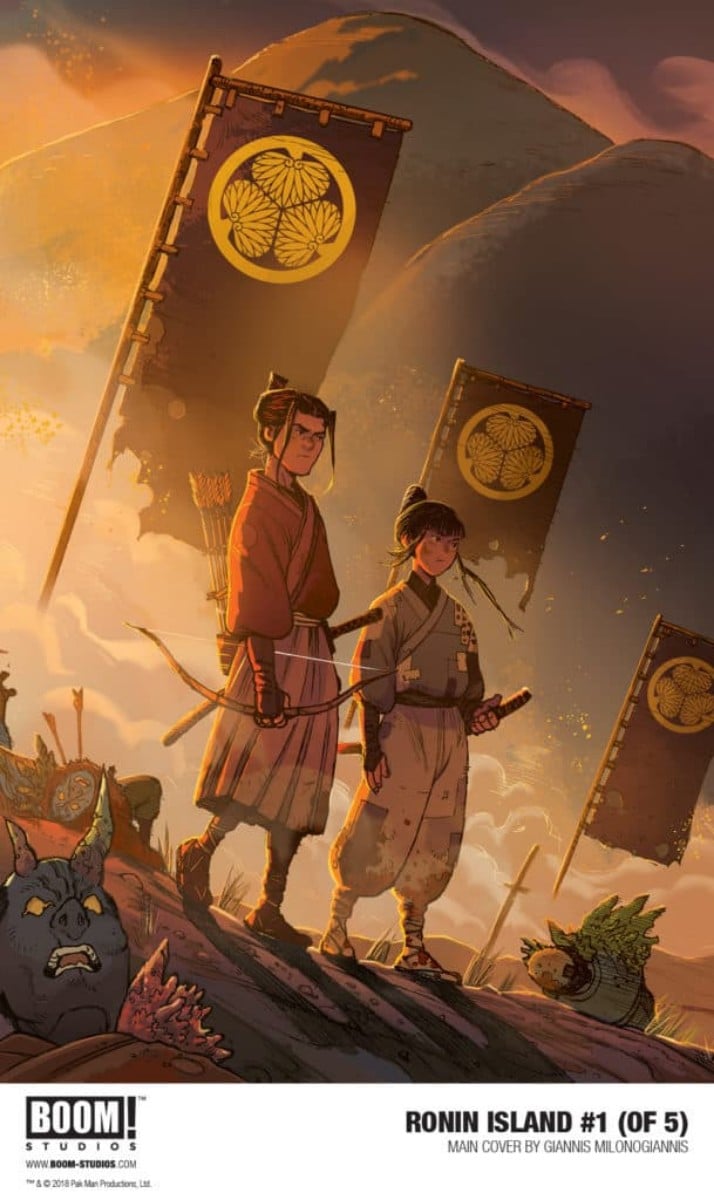
Writer: Greg Pak
Artist: Giannis Milonogiannis
Colorist: Irma Kniivila
Cover Artist: Giannis Milonogiannis
Publisher: Boom! Studios
Eric: I’m trying to branch out from my regular pulls of traditional superhero fare like Daredevil or Spider-Man, so I decided to take a look at Ronin Island. Without any expectations – I had read nothing about the book, no previews or anything, I just thought it might be fun to read a samurai story – I checked out the first issue of Boom! Studios’ new limited series by Greg Pak and Giannis Milonogiannis.
Ronin Island dives right into a competition between two samurai-in-training: Kenichi, who is striving to live up to the legacy of his father, a samurai who was the first protector of the island where they live, and Hana, who obviously exudes talent but seems to lack the motivation to be her best self. On their graduation day, the two are pitted in a race that tests their physical abilities as well as their cunning. This will determine who will be the top graduate.
The finish of the race is interrupted by the arrival of General Sato, who arrives on the island claiming to be an envoy for the mainland’s new Shogunate. Sato demands loyalty from the Islanders, and in return, he promises protection to the island from a mysterious new threat that has arisen on the mainland. The Islanders are skeptical, claiming that the Shogunate was wiped out during the Great Wind disaster. The Great Wind, we have learned, occurred 31 years ago, causing mass devastation, and creating an isolated island, entirely separated from the nearby mainland. The Islanders come from China, Japan, and Korea.
But despite the disbelief of the Islanders, Sato persists, and finally convinces them of the threat: a legion of samurai monsters hell-bent on destruction!
Greg Pak’s story moves quickly, at an almost frenetic pace. There’s a lot going on in this first issue: a samurai student race, a confrontation with a new imposing shogun, and warrior monsters!
And therein lies my concern with this first issue of Ronin Island: I’m not sure what exactly this book is supposed to be about, yet. I thought the premise that began the book – samurai students on a seemingly-isolated island – was interesting enough, and I enjoyed the storyline about the race between Kenichi and Hana. The story really tries to make the contrasts between the two students obvious: Kenichi represents traditions and legacies, while Hana shows the value in trying things outside of tradition. I didn’t get much of a sense of either character outside of these generalized qualities, but I’m hopeful more character development will come in subsequent issues.
But then the book completely switches direction, and Kenichi and Hana somewhat fade into the background while the story diverts to General Sato, the new Shogunate, and the invasion of the samurai monsters. This abrupt change completely halts the momentum of the more compelling theme of the first half of the story, where characters from different backgrounds and cultures come together and find common ground. I think if the focus on Kenichi and Hana had been developed further, over the course of a full issue or two before introducing the ominous new threat, I would have been less bothered by the stark switch in direction.
The art from Giannis Milonogiannis and colorist Irma Kniivila serve the story adequately, but the swift change in direction makes for an odd contrast in the tone of the artwork as well. The first half of the book, where the focus is on Kenichi and Hana, is brighter and filled with lighter and bluer colors. When the story switches, the artwork becomes somewhat darker, with reds, browns, and oranges providing the palette. Again, it serves to make me wonder which story Ronin Island actually wants to tell.
Even though issue #1 began with a promising concept that felt underdeveloped before switching gears, I’m intrigued enough to see where the story goes. I may check out issue #2 just to see what happens; hopefully Ronin Island can find its footing in future issues.
Wizard Beach, Issue #2

Writer: Shaun Simon
Pencils: Conor Nolan and George Schall
Inks: Chad Lewis
Colorist: Meg Casey
Cover Art: Conor Nolan
Publisher: Boom! Studios
MAJK: Hexley Daggert Ragbottom is a Wizard, and he’s less than pleased at being trapped at Wizard Beach by his Uncle Salazar (who prefers to be called Sally.) Hex came to find his uncle in hopes of learning the magic he needs to save his homeland. Sally (who insists on calling Hexley “Hex,”) meanwhile, is determined to show his nephew that there is more to life than freezing and fighting.
In Wizard Beach #1, Hex found himself trapped in this confounding world of “burning hot grounds” and “processed meats.” Wizard Beach #2 sees Hex go from confused to angry when he finds that he is trapped on Wizard Beach by Sally’s curse. Indignant, annoyed, and disillusioned, Hex demands that Sally uncurse him immediately. Unfortunately, the terms of the spell are quite clear. Hex may leave Wizard Beach as soon as he understands more about life.
Simon continues to spin a fun tale in this issue and Sally’s charmingly eccentric personality is still on display but in this issue, but now we see a bit of the seriousness that undergirds it. Sally reminds Hex that “all those fighting and freezing in the mountains.. they don’t have to stay there.” It’s the little bits of truth that Simon warps in a magical cloak of fun that makes this such a treat.
Nolan and Schall work together to bring us an art style is the perfect blend of comic and cartoon which adds to the atmosphere of fun. The visual magic of the art and colors give us some great emotive faces, particularly when Hex and Agnes interact. Faces, as well as postures, evoke all the awkwardness of meeting someone you like for the first time. That depth is impressive given the light-hearted feel of the comic as a whole. Meg Casey does a remarkable job on colors. The bright splash of summer, juxtaposed with the muted tones of the interior shops feels much like when you walk out of the sun indoor in real life. I think my favorite art moment was when Hex was underwater during his first surfing experience. That scene is just gorgeous.
This issue wraps up with an ironic and yet provocative moment. Hex has rented a room at The Keep following a disastrous attempt to create a castle on the beach out of salvaged junk. The desk clerk reminds him that “At The Keep, the room becomes the place you need to be the most.” Where Hex finds himself as he walks through the door isn’t where he expected.
Wizard Beach, Issue #3
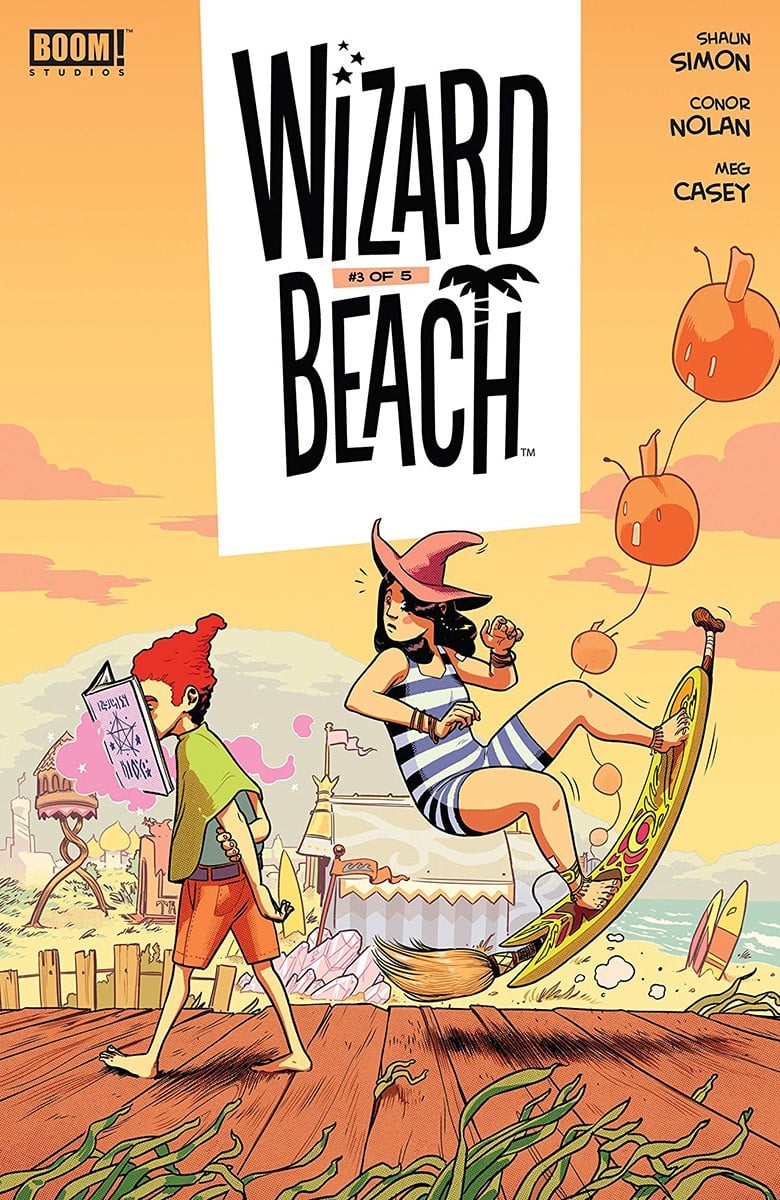
Writer: Shaun Simon
Artist: Conor Nolan and George Schall
Inks: Chad Lewis
Colorist: Meg Casey
Cover Art: George Schall
Publisher: Boom! Studios
MAJK: This title is great fun. I love the chance to catch up on it finally. In Wizard Beach Issue #2 (just above here!) Hex ran across one of Sally’s Wizard friends in an alley. As suspicious as things looked, Hex dismissed it at the time because… well, your beach house bursting into a blaze will tend to distract you.
Wizard Beach Issue #3 opens with a bit of intrigue as we see several trusted cohorts of Uncles Sally in a clandestine meeting with an unexpected informant who claims to have “found out more about Salazar than I would have cared to.” What this little group is conspiring over is left to the imagination, but it’s clear that it centers on Salazar.
Hex, meanwhile, has discovered sunburn and come face to face with the face that Sally is friends with a Frost Giant. As you might recall, the Frost Giants are the mortal enemy of Hex’s people back home. You can imagine that went over well.
Still focused on his goal of breaking the spell that binds him to the beach, Hex hits the library. Head in his studies, the poor lost soul wanders through the boardwalk entirely missing the fun and happiness all around him. The creative team’s visual rendition of Simon’s metaphor is a full page of whimsical cleverness.
Hex falls for Agnes, quite literally, and discovers that the seemingly inconsequential moment in the alley during the last issue has a genuine impact on this lovely young witch. In spite of his chronic obliviousness, Hex attempts to do something lovely for Agnes with predictably amusing results. While things don’t quite go as Hex planned, Agnes introduces him to the concept of fun. Unfortunately, Hex’s preoccupation with finding the magic he came her for interrupts their day. Agnes sadly watches as Hex rushes off, his opinion of his uncle altered by a rainy moment in the Wand Ball tournament.
Simon does an excellent job depicting a budding friendship, and the blunders committed by the clueless but well-meaning Hex. Agnes is a delightfully engaging character that begins to work her way to the forefront of the story. The creative team continues their trend of emotive visuals, as the enjoyable interlude between Hex and Agnes gives way to a poignant moment in the final panel that exquisitely establishes the pain of unrequited feelings.
Be sure to join the entire lunatic menagerie of witches, wizards, and all manner of natural creatures in Wizard Beach #4 as we move toward the end of this enchanting tale.
Rainbow Brite, Issue #5
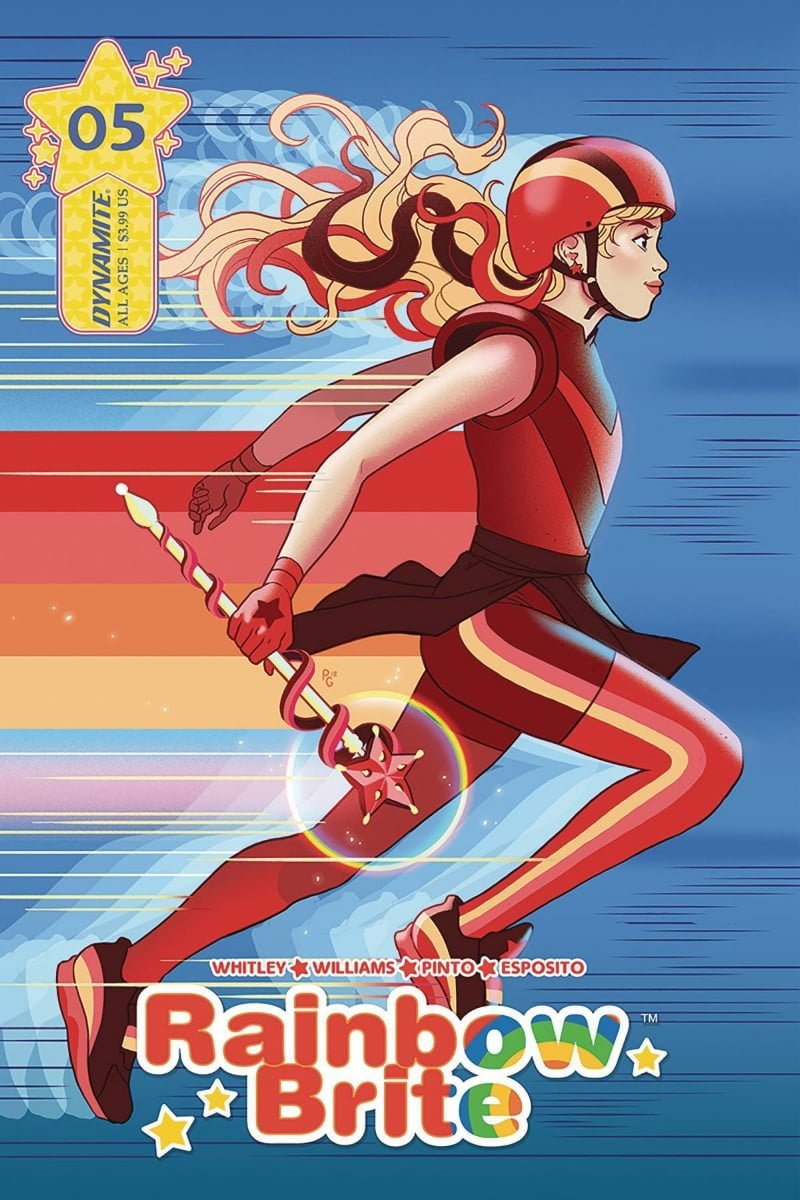
Writer: Jeremy Whitley
Artists: Xenia Pamfil on pencils, Christine Hipp on inks
Colorist: Valentina Pinto
Cover Art: Paulina Ganucheau
Publisher: Dynamite
Kay: At the end of Issue #4, Wisp had picked up the powers of the Red Color Guard, and was using his superspeed to try and outwit the robots that were chasing them. Despite her best (and really adorable) efforts, both she and Red end up captured and tossed in a dungeon. Wisp wakes up slowly and finds herself surrounded by Twink, Lucky (a green sprite) and the Green Color Guard. They also meet Gloomy, the Ultraviolet color sprite; he’s invisible unless he concentrates. Gloomy is an N.V., or non-visible – and pretty cranky about how he’s never on stickers or flags. Frankly, it’s pretty adorable.
We get a couple of great things in this issue. Some backstory on Twink, and how a white sprite was basically ostracized – all sprites are colored, and since his parents were red and yellow, he was expected to be orange. Because of this, he spent much of his time studying about Rainbow Brite – which is why he’s so confident that he has now found her.
Gloomy also decides that Wisp smells like something odd… “markers and pencil shavings and ink.” Remember back in the first issue, when Wisp was wearing her friend Willow’s raincoat? Gloomy uses that to home in on Willow, back on their planet.
I was so excited to see Willow again! Back in our world, Willow is trying to explain to her parents and the police what she saw the night Wisp disappeared. That is going…poorly. Gloomy finds her, grabs her, and (presumably) transports her to Rainbow Land with a big sha-krak!
My level of excitement about Willow and Wisp being reunited is beyond belief. The friendship between these two girls was so incredible, and we need so many more friendships like that in fiction of all kinds. Willow and Wisp taking on Rainbow land together? Freaking gimme.
Based on solicits, this is the end of the first arc, and the trade should be out in June. Dynamite, from what I’ve seen, publishes their kids’ comics at full size, not digest, which I could not support more. I am absolutely buying this in trade. Zero questions. I absolutely adore this book.
Friendly Neighborhood Spider-Man Issue #4

Writer: Tom Taylor
Artist: Juann Cabal
Colorist: Nolan Woodard
Cover Artist: Andrew C. Robinson
Publisher: Marvel
Eric: Friendly Neighborhood Spider-Man Issue #4 continues Tom Taylor’s introductory arc. Spider-Man is returning from last issue’s trip to Under York, a subterranean replica of New York City where he and his mysterious neighbor Marnie (who has superpowers herself and goes by the name “The Rumor”) fought a bunch of super-strong orange skinned goons while attempting to rescue another neighbor and reunite her with her orange-skinned children in the surface world (whew!).
Spider-Man meets back up with Human Torch, who had been babysitting the children and starts to mend the wounds suffered the last issue. But suddenly, the neighborhood is rocked by explosions as the leader of the Under York goons arrives from the depths and threatens to destroy the city unless Spider-Man surrenders the children to him! Spider-Man challenges him and gains some unexpected assistance from the citizens of the neighborhood and a familiar Marvel villain who surely has more ominous motives.
Tom Taylor’s first arc has been a lot of fun. Taylor perfectly captures the snark and sarcasm of Spider-Man, and the dialogue between Spider-Man and the supporting cast, especially Human Torch, is amusing. Taylor also weaves a poignant moment in at the beginning of the issue as Spider-Man reminisces about how his Aunt May and Uncle Ben took him in and correlates that to how his neighborhood steps in to help those in need.
I must say that the resolution to this issue felt somewhat anti-climatic, foregoing much of an action sequence in favor of more exposition with Spider-Man’s neighbors and allies. But, the descriptions for this title did indicate that the book’s focus would be on the smaller-scale world of Spider-Man’s neighborhood instead of a more bombastic and broad expanse of Spider-Man’s world (like what you might see in Amazing Spider-Man), and I think Taylor accomplishes that focus with this story. On top of that, Taylor provides hints of a sinister conspiracy and an upcoming storyline that will surely affect Peter Parker’s relationship with Aunt May.
Also, I have to express my delight in Juann Cabal’s artwork. Cabal has the capacity to become a legendary Spider-Man artist if he continues in this fashion. His figures are dynamic and he conveys emotions well through facial expressions, and his rendering of action sequences is great – the main two-page action scene in the book, punctuated by Taylor’s writing of Spider-Man’s inner monologue, was a lot of fun to look at.
All told, I’m thoroughly enjoying this run of Friendly Neighborhood Spider-Man so far.
Rat Queens Volume 2 Issue #15

Writer: Kurtis J. Weibe
Artist: Owen Gieni
Cover Artist: Jim Valentino and Owen Gieni
Publisher: Image
MAJK: “Every new beginning comes from some other beginning’s end.”
Rat Queens Vol 2 Issue #15 evokes a memory of a half-forgotten 1998 tune by Semisonic. Following on the heels of what I would argue was the most intense issue of Volume 2 , Rat Queens #15 wraps up the most powerful story-arc of this season.
Orc Dave and Braga took center stage in this emotional story, but there’s a lot to unpack here for all our characters. During the last issue, Wiebe dropped the bombshell that is Dalen on Dave, and the devastating impact was heart-wrenching. Vi dishes out some very personal revenge on the Flesher in the process of mangling her beloved. That’s one of the things I love about our Queens; they are whole people. Vi’s gutting a flesher one moment and then tenderly offering Dave the support he needs to handle the guilt and pain of what his son Dalen has experienced.
Braga, meanwhile, is spitting in the eye of her past. Rat Queens fans will remember learning quite a bit about that past in RAT QUEENS SPECIAL: BRAGA #1 (Jan 2015). Not only was it revealed that Braga walked away from her birthright as a Chieftain, but we also learned that Braga is transgender. This fact was never explicitly stated in the story dialogue. Frankly, I think that helped give it more impact while on some level normalizing her transition. Tess Fowler’s art did the heavy lifting back then.
Now, Wiebe deftly brings the tale full-circle and makes clear that the transition from Broog to Braga was more than just physical. While it was clear that Braga never really fit with the tribe she was born into; there’s the triumphant moment when she claims her rightful tribe, reminding us that the word family means a lot more than the blood with which you are born.
If you haven’t read that special by this point, I strongly recommend it. It lends a lot of depth and meaning to the events in this issue. Also, learning both the identity of Braga’s lost lover and the betrayal she suffered profoundly elevates the wisdom she drops on the Queens. “That’s the thing with Life – Our Choices, well intended, Selfish… whatever. They always revisit us somewhere down the line.”
BOOM!
Wiebe leaves us with a reminder of all that makes the Rat Queens so incredible. He also gifts us with the most incredible “Happily Ever After” moment to date. Gieni for his part leaves us with artwork that is just as incredible. Braga is both beautiful and fierce as she faces down her brother. Every moment, whether combat or commentary, is visually engaging. The final page is truly glorious. This issue wraps in such a way that there’s no doubt another great adventure is beginning. I can’t think of a better hand-off for the new creative team.
West Coast Avengers Issue #9
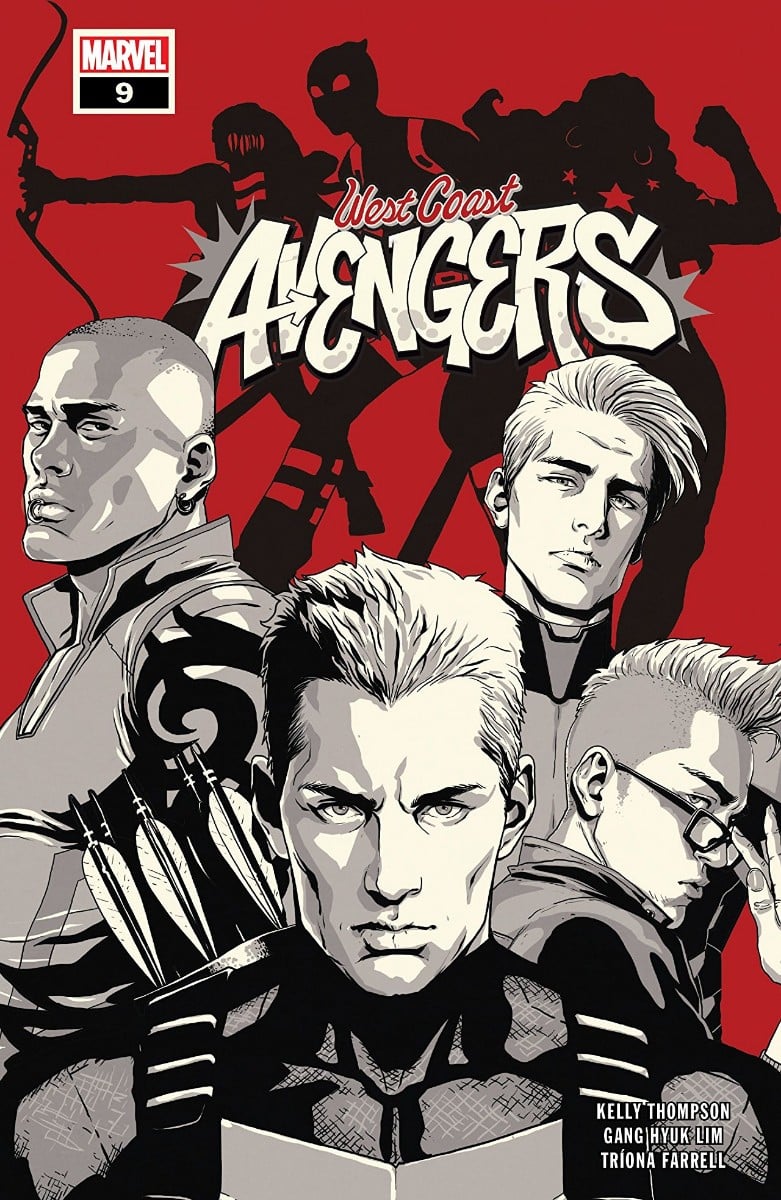
Writer: Kelly Thompson
Artist: Gang Hyuk Lim
Color Artist: Triona Farrell
Cover Artist: Gang Hyuk Lim
Publisher: Marvel
Kay: I’ve loved West Coast Avengers since the first issue. It has my favorite characters from Young Avengers, the not-as-good Hawkeye (sorry, Clint), Gwenpool, and a new, badass Black guy superhero. America Chavez and Ramone are dating, and while I can’t speak to the specific importance of an interracial lesbian relationship where neither person is white, I can’t help but think that’s really meaningful to a lot of people.
So when I heard that this is the penultimate issue in the series and that Issue #10 is the end, I just about lost my shirt. Completely and totally. I’ll spare you my rants about loss leaders and Marvel’s utter failures at really and truly recreating “the world outside my window” (you can read them here if you want to) but if you can’t sell West Coast Avengers, you’re doing everything wrong as a business and you deserve to fail.
In this issue, we see Kate and Clint strung up like meat, Noh-varr and Fuse trying to get out of a pit, Quentin and Gwen trying to get to the cult to save everyone. In a fantastic sequence, Ramone becomes a hero in her own right, (after noting that as a Black woman surfing champing who runs her own business, she already IS a hero) discussing that her mother was one of the Dora Milaje, the sacred protectors of the Black Panther. She dons a vibranium ring – like the one Johnny wears as a lip ring – and it fuses with her body to become a vibranium suit of armor. They rescue everyone except America – who has been bitten by vampires.
At the end of the issue, Kate’s mother decides to take a bite, too.
Gang Hyuk Lim’s art found a consistency in this issue that I really appreciated. In the last couple of issues, I’ve found the art to be just – one panel is exceptional, the next is meh. In this issue, there wasn’t a panel or a face (I am obsessed with faces in comics) that felt really off kilter at all. Excellent work that I absolutely loved.
Here’s what disgusts me about this issue: Ramone’s story should have been at least an issue, and could have been an arc. Kate and her mom deserve an entire freaking series.
It is absolutely infuriating that West Coast Avengers is getting canceled – and, yet again, the cancellation happened before the trade was even out, even though we have seen over and over again that books with diverse characters or casts do better in trade than they ever do in single issues. Two weeks after release, West Coast Avengers has just now dropped below #100 in the Marvel GN category on Amazon. There’s no way to tell exactly what those numbers mean in terms of sales, but I can tell you that the books selling better are all older titles or titles with big movies out or coming out. (Captain Marvel, Infinity War, etc.)
West Coast Avengers Issue #10 will probably be fantastic because the entire series has been fantastic. Thompson’s ability to provide deep cuts to old comics without alienating new readers is phenomenal. Bringing back little introduction boxes for new readers is one of the best choices I’ve seen in comics since I started reading again in the early 2010s. And it’s canceled.
Just do better, Marvel. Do better.
Also, buy West Coast Avengers in trade. It’s adorable, funny, and everything a team book should be.
Vampirella/Dejah Thoris Issue #5
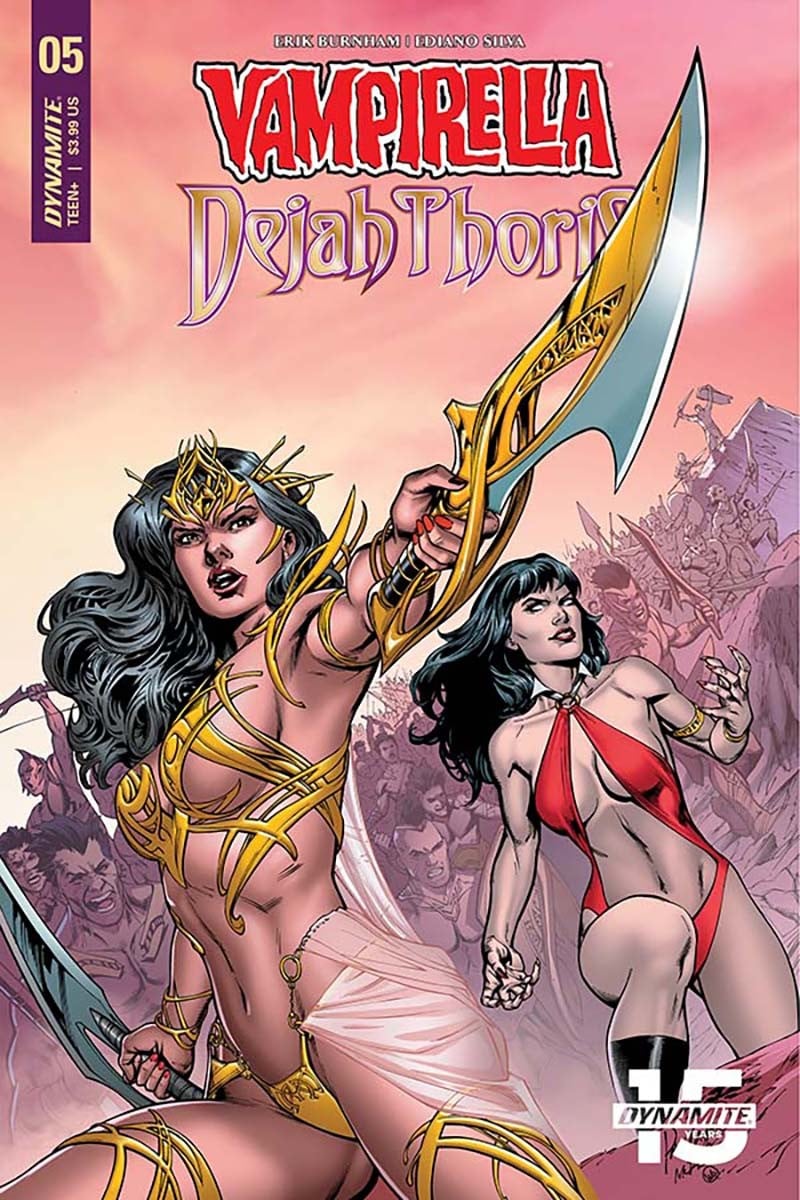
Writer: Erik Burnham
Artist: Ediano Silva
Color Artist: Dinei Ribeiro
Cover Artist: Carlo Pagulayan
Publisher: Dynamite
MAJK: Vampirella / Dejah Thoris Issue #5 opens with a huge number of threads to tie up from the last issue. Every bit of this series has been filled with fun twists and intriguing political machinations. Unfortunately, I feel like the wrap up was a bit rushed. A lot of story opportunities were missed by resolving all that has been built up it all in a single issue.
It’s too bad because the interaction, and specifically the collaboration between Vampirella and Dejah, has been the best part of this series. The ladies have returned from defeating Issus; an entourage of scientists came with them. Unable to wait until she could convince her father that other options beyond destroying the Drakulons existed, Dejah Thoris took it upon herself to bring the Ships of the Drakulons down safely.
Unfortunately, this set many things in motion.
While Dejah describes to her father the technological advances she has encountered during her adventure, Gus Tur (a.k.a. the Xenophobic jerk face) is preparing to drive the Starving Drakulons through the Carrion Caves. There, he hopes the vicious creatures known as Apts will thin the number of Drakulons. He intends to herd the remaining Drakulons toward the Okar city. In his kill or be killed mindset, he considers the people of Okar an acceptable loss to protect Helium.
Once more, Gus Tur illustrates the narrow mindset that sees violence and destruction as the only solution.
For a book with art clearly designed to appeal to the male gaze, it’s rather intriguing to watch as the women outsmart not just one or two guys but the entire Patriarchal government. I’ve mentioned before that this series blows past the Bechdel test; we have named women not only talking to each other about something other than a man, but debating strategy, technology, and changing the course of foreign policy.
Okay, sure, they do it in less clothing that most women wear to the beach but hey, small victories.
Overall this series has been fun. Burnham’s plot has been intricate, his writing has been excellent, and I’ve very much enjoyed Silva’s art. Unfortunately, this is the part where I list my complaints. While nothing gave me as much pleasure as watching Vampirella give Gus Tur the beating he so richly has deserved, there were more than a few moments that left me flat.
Devout worshippers of a goddess went from “She’s dead” to “Let’s work together” in the blink of an eye without even a modicum of anger or hatred toward the person who killed her. Excusing Gus Tur’s behavior due to a head injury struck me as a bit odd. The guy has been a man-splaining, xenophobic jerk this entire series. His attempt to kill Vampirella was something we could see coming a mile away. His violence toward Dejah Thoris was not exactly out of character for him. I’m not saying he needed to die but did we need to excuse him?
Also skipping over the work and frustration of creating a blood substitute, and a stable water supply for Barsoom in a matter of panels felt a bit flat after such a well-crafted build up. Dejah Thoris’ decision, to not to do what she’s always wanted to do, came far too quickly for a woman who we’ve watched think her way around numerous obstacles. Still, if you had to wrap this tale in a single issue, this wasn’t a horrid way to do it. I just felt like there was so much more that could have been explored or maybe I just enjoyed the series that much.
Marvel Rising Issue #1
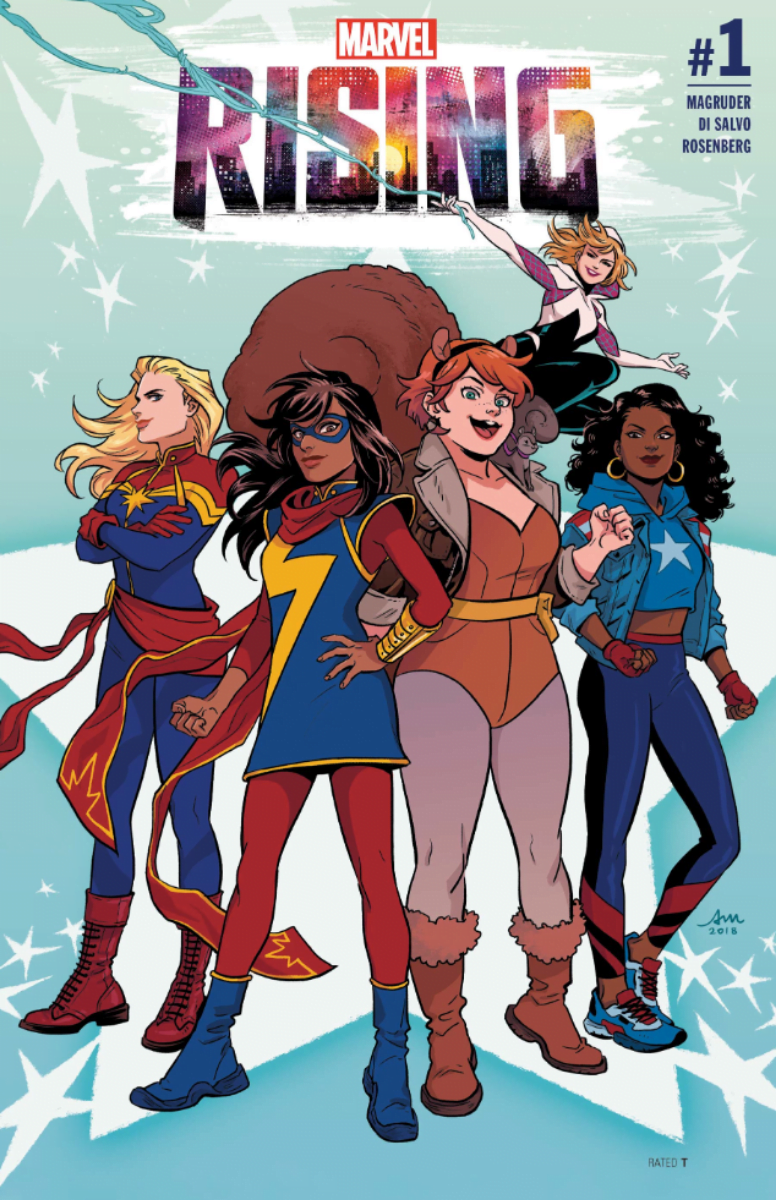
Writer: Nilah Magruder
Artist: Roberto Di Salvo
Colorist: Rachelle Rosenberg
Cover Artist: Audrey Mok, Variant Covers: Peach Momoko, Ron Lim & Israel Silva
Publisher: Marvel
Kay: I’m really not sure at this point what to think about Marvel Rising. So far, there have been cartoons and comic books. I still haven’t gotten a chance to watch the cartoons, because I originally understood them to be on the Disney Channel and only recently realized that they were available on YouTube (going to fix that shortly). Then there was the comic series where Ms. Marvel and Squirrel Girl teamed up to catch a nascent supervillain in the coding class that Doreen was teaching and Kamala was taking. This series, as a side note, was a hot mess to read in single issues and is even worse in digest form. My vision is really good and I almost needed one of those reading magnifying strips to make out chunks of dialogue. Ridiculous.
But I’m here today to talk about the first issue of Marvel Rising, which is a new (ongoing?) comic book series. The story is a pretty basic comic book story. Doreen (Squirrel-Girl, and suddenly a teenager instead of a teacher again) is taking Miles Morales (Spider-Man), Kamala Khan (Ms. Marvel), Dante Pertuz (The Incredible Inferno), and her bestie Tippie-Toe, on a tour of the local college to discuss what majors they might be interested in.
Why? Dunno, but it’s a superhero comic, so okay. Why do they all go do this tour, however, in their superhero costumes? Really really don’t know. The first two-page spread is a big fight scene, but it ends with “You’re probably wondering how I got into this situation,” which is my least favorite plot device ever. The superheroes are fighting jousting cars (I guess)…and then we’re out on Staten Island, where Morgan Le Fay is fussing about some crystal and considering taking over New Attilan, home of the Inhumans. Why? Still dunno.
The biggest, most important job of Issue #1 in any series is to make me want to read Issue #2. If this does that, it’s only because I hate quitting books. It gets one more issue from me, and then I quit.
One thing that I did enjoy in the book from a formatting perspective; the front page of the book had a small head sketch and description of each character in the book. It’s so much easier to read when you have some understanding of who the cast is.
Invisible Kingdom Issue #1

Writer: G. Willow Wilson
Artist: Christian Ward
Colorist: Christian Ward
Cover Artist: Christian Ward
Publisher: Dark Horse
Eric: Invisible Kingdom, the new release for Dark Horse’s Berger Books imprint, co-created by G. Willow Wilson and Christian Ward, begins strongly with its first issue.
Wilson weaves a tale of conspiracy and intrigue featuring the dichotomous storylines of two heroines in a far-away solar system. The first, Grix, is a freighter pilot who guides her ship through a crash landing caused by mechanical issues. As Grix assesses her ship’s damage cargo, she discovers irregularities in some of the manifest records that causes her to suspect more nefarious activities on the part of Lux, the mega-corporation that employs her. The second, Vess, is a new initiate to the convent for this solar system. She makes her way to the monastery and pledges her service to Mother Proxima, who assigns her to record-keeping and bookkeeping duties. As she works, Vess too discovers some oddities in the monastery’s business dealings with the looming Lux corporation that will almost certainly intertwine the heroines’ stories in future issues.
G. Willow Wilson’s script provides insight into this fantastic new world through the different voices of the two lead characters. Grix’s story is more tempestuous; we are introduced to her as her ship is about to crash, and her overall demeanor seems to lend itself to more volatile story elements. Meanwhile, Vess is a more solemn character, as is her story. Vess’s tale is calmer and quieter, as she journeys to the monastery and devotes herself to its contemplative lifestyle. She does encounter conflict, but it is more understated than the brashness of the conflict Grix experiences: Vess must move forward through ridicule from members of society, and even fellow novitiates (they are referred to as “Nones” in this world), who don’t appreciate or misunderstand the commitment to a lifestyle that Vess accepts. I found myself fascinated by both characters, and curious to see how their different journeys will certainly interconnect in future issues.
Wilson seems to have a point to make with Invisible Kingdom as well. Throughout this issue, it’s clear that Invisible Kingdom will serve as an allegory to our current society where a few mega-corporations seem to be gaining an overarching influence in our daily lives (surely Lux represents Amazon here).
Wilson weaves in some not-so-subtle warnings about the nature of materialism and of letting certain business accumulate too much power into some characters’ dialogue but provides an interesting contrast to this through Vess, who gives up material things to live a life of minimalism. Wilson also hints at an upcoming exploration of gender, as we learn that Vess is a “Down,” the rarest of four sexes on her home planet of Rool. There seem to be expectations of these various genders that we are sure to learn about in coming issues. Those hoping for a more bombastic, space-battle type of sci-fi story are not going to find it in Invisible Kingdom – this is a more contemplative tale that seems to want to probe themes that are prevalent in our daily lives through a fantasy tale of space aliens. And, somewhat unexpectedly, I actually really enjoyed it.
The art in Invisible Kingdom must be commended as well. Christian Ward deftly illustrates Wilson’s script, especially the contrasting scenes for Grix and Lux. Grix’s scenes have a more chaotic style, with more frenetic linework and bombastic colors, while Ness’s scenes feature somewhat-cleaner lines and muted tones. The dichotomy between their stories and in the art is perhaps best rendered through two sequential splash pages early in the book, where Ward presents the violent fall and crash of Grix’s ship and then the ascension by Vess to the almost-ethereal monastery. And, back to the coloring, I don’t remember the last time I paid so much attention to the colors in a comic book, but they work to fantastic effect in Invisible Kingdom – I was mesmerized.
I never would have imagined that I would have so thoroughly enjoyed a dramatic space nun conspiracy comic. If the following issues are as captivating as the first, I might just have to make reading Invisible Kingdom a habit (see what I did there?).
Ironheart, Issue #4

Writer: Eve Ewing
Artist: Luciano Vecchio
Colorist: Matt Milla
Cover Artist: Amy Reeder
Pubisher: Marvel
Kay: Ironheart continues to be awesome. This issue digs a little further into the origin story created by Brian Michael Bendis in Invincible Ironman: Ironheart, specifically about Riri’s feelings about her step-father. When she and her mother discuss him, Riri points out that while her mother refers to him as her step-daddy, he was the only father Riri ever knew, and that he was more than that. Later, when Midnight’s Fire comes to Riri’s Chicago Lab (aka, her Mom’s garage) to taunt her about the Ten Rings, Riri screams that she had a father, the best father and that he died because of people like Midnight’s Fire.
This issue is, as you probably got from that first paragraph, very much a “let’s have the villain share his motivation” issue. Midnight’s Fire relates his history with the Ten Rings to Riri, and then invites her to join him. He says that he sees in her the same sorts of passions and beliefs that drove him to success within the group.
Riri totally snaps. With N.A.T.A.L.I.E. trying to get her to back off, Riri attacks Midnight’s Fire; while she gets him at a disadvantage once, he quickly overcomes her, pulls off her face mask, physically threatens her, then uses his power to push her to sleep. He leaves her in a heap among her broken computers and equipment.
A lot of times, I find this issue in an arc to be incredibly boring. Ooo, villain motivation, yay. I’m not anti-hero kind of girl. But Ewing managed to make this interesting, and while I’m not going to sympathize with Midnight’s Fire, I do appreciate knowing more about what’s going on with his organization at large. I love the art and colors by Vecchio and Milla respectively and continue to love the way they communication emotion and action with equal ease. There’s one particular panel where Riri and her mom are touching their foreheads together, their arms on each other’s shoulders, that feels quiet and calm and safe, two women protecting each other from the world.
I love this book, I love the ongoing story, and I can’t wait to see what happens next.
Sabrina The Teenage Witch, Issue #1

Writer: Kelly Thompson
Art by: Veronica Fish and Andy Fish
Main Cover: Veronica Fish, Variant Covers: Stephanie Buscema, Adam Hughes, Victor Ibanez, Sandra Lanz
Publisher: Archie Comic Publications
Kay: Okay, if you spend one minute talking to me, you know that I’m a complete Kelly Thompson fangirl; it’s just the truth. The last time I read Archie comics, I was picking up the Digest versions from spinner racks at the local corner store, but they were really my comics gateway. All I knew about Sabrina, however, was from the old TV show with Melissa Joan Hart. But seeing my favorite writer tackling my gateway comics world was more than enough to get me picking up issue #1 of Sabrina, The Teenage Witch.
I said above that the job of an issue #1 is to get you reading issue #2, and this does that in spades. It gives me a character introduction, in case I need one. Sabrina is a teenager, a witch, has a cranky talking cat, and lives with two adult women. In the TV show, they were Sabrina’s aunts, but I’m low-key hoping they get to be her lesbian moms here.
This issue focuses on Sabrina’s first day at her new school. She makes the mean girl mad (don’t we all) befriends the girl the mean girl is focusing on (good choices) and finds a couple of nice, cute guys to talk to; one of the cute guys is the mean girl’s twin brother (always). But while walking home with her new friend, the girls are attacked by a Wendigo. Sabrina’s out of magic and can’t focus, but just before she and the girl are hurt, the creature breaks apart into two people – the mean girl and her twin brother. Uh-oh.
This book gave me an introduction to the world, reasons to care about Sabrina, and a hook to keep reading. The art is just gorgeous. Backgrounds are detailed without being George Pérez levels of intense, and when it’s simpler to just have a wash of color in the background so we can focus on Sabrina or another character, that’s what we get. Sabrina starts of swearing that she won’t use her magic casually…then totally uses her magic casually, which is why she’s out by the end of the day. And at the end of the day, she has given in and cast a spell on the mean girl: “Slip and fall is just the start. You can’t hide your evil part. A true self reveal, not your fake ideal.” Okay, making Radka, the mean girl, fall face first into the mud isn’t exactly kind, but how many times have we all wanted to push the mean girl into the mud?
There is just one thing I find concerning, and I need to be clear that I am twenty-seven kinds of out of my lane saying this, so if there are reviewers or fans of color who believe I am out of line here, I will absolutely bow to authority. Both Jessa, Sabrina’s new friend, and Radka, the mean girl, are drawn with brown skin tones. Jessa’s is significantly lighter than Radka’s. Given the amount of colorism that (I am told) exists within Black and POC communities, I find this very, very concerning. There are some kids in backgrounds who are drawn as non-white, but only a handful. Also, a storyline where the brown kids turn into monsters or beasts has the potential be really badly racist.
So overall, I love issue #1, I have some concerns, and I hope that as the story moves forward, more characters are introduced that continue to diversify the overall cast. I hope there’s also a solid reason why the primary brown-skinned characters are the ones turning into some kind of magical beast. The book goes on my pull list, and we’ll see what happens next.
Star Wars Age of the Republic: Padmé Amidala
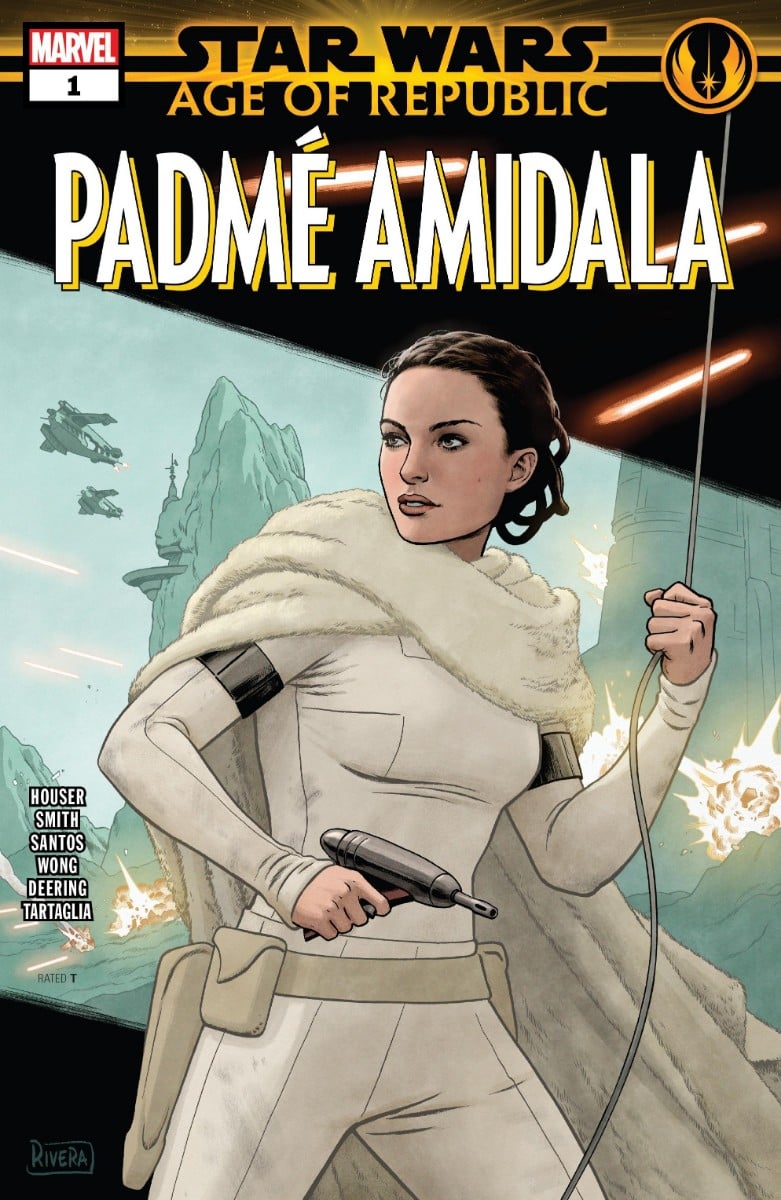
Writer: Jody Houser
Artists: Cory Smith, Wilton Santos
Inkers: Walden Wong, Marc Deering
Colors: Java Tartaglia
Cover Artist: Paolo Rivera
Publisher: Marvel
Kay: I’m pretty bad at being a Star Wars fan. I’ve watched all the movies, but when it comes to the new or old Expanded Universe, I’ve pretty much engaged with books written by authors I already knew and enjoyed. Until recently, this pretty much meant E.K. Johnson’s Ahsoka.. But when I was at my LCS, I noticed that Jody Houser had written a Star Wars: Age of Republic – Padmé Amidala issue, I grabbed it, figuring it would be a good read. Given how amazing Captain Marvel: Braver and Mightier was, I hoped it might catch an edge of that wonder.
This was a good, solid read. It’s hard to write what is essentially a microstory in a monstrously big universe. It definitely does showcase the things about Padmé we know and love – she carries a blaster, she’s brave, she kicks ass even in big heavy dresses. It mentions that she’s kissing Anakin in corners even though she’s not supposed to, which you may or may not love. She’s deeply devoted to the Republic, and wants to see a universe where people “don’t have to choose sides.”
What this did not do was add to my understanding of Padmé. Maybe this is because I’m in the middle of another story about why she became a senator, how that changed her life from what she was considering when her term as Queen ended, and how she continued to operate with her handmaids in the Senate. This issue also did not particularly add to my understanding of the Age of the Republic. A Senator goes to a neutral planet to try and convince it to join the Republic. There’s a battle; the planet decides to join.
Still, I enjoyed the book; the art is pretty, and there’s a nice sense of motion within the battle scenes that are helpful to understanding what’s happening. That said, there are moments where the art and the writing seem somewhat disconnected from each other; for example, Padmé is saying something that feels like it’s in a wry tone, but the expression doesn’t match.
I’m not going to buy any more Age of Republic issues because of this one, but I don’t regret the money I spent on it.
***
And so ends the massive catch-up Comic Book Corner. What do you think? What do you love? What are we missing? Let us know!




Thanks for the kind words on Vampi/Dejah!
If it helps contextualize the plot any, about midway through writing issue 4 we found out it wasn’t going to be out of continuity — so that changed the plan for #5. Still, I had fun.
Thanks again!